RFQ vs RFP: What Vendors Need to Know Before Responding
Understand RFQ and RFP differences and their strategic impacts. Compare purposes, demands, and their usage contexts for smarter procurement. Click to learn more!
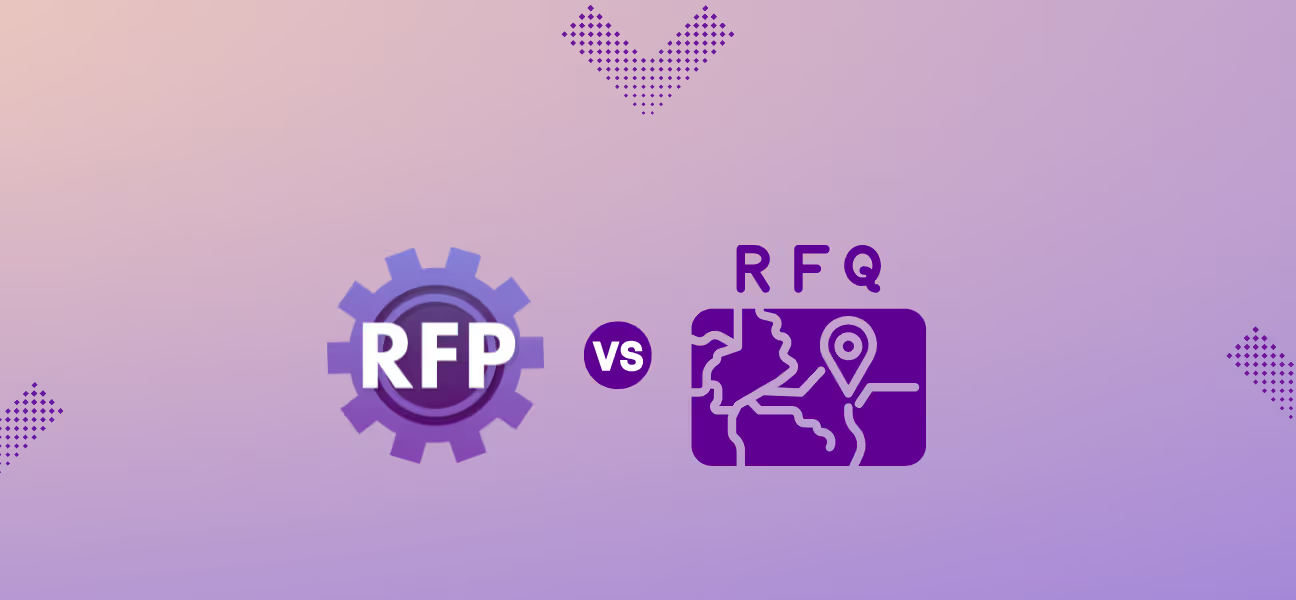
Not every proposal is worth the pursuit. Yet sales, proposal, and solutions teams often treat RFQs and RFPs the same. They spend approximately 23 hours per RFP response on opportunities that are poorly qualified, low-value, or misaligned with their strengths.
If that time is spent chasing mismatched deals, you're stretching already limited bandwidth. Thus, distinguishing RFQs from RFPs is essential.
The clear distinction is that RFQs are fast, price-first requests, while RFPs are complex, resource-intensive evaluations. Confusing the two can lead to missed quotas, overworked teams, and low win rates.
This guide breaks down the real-world differences between RFQs and RFPs from the vendor’s perspective. You’ll learn how to assess effort versus value, qualify faster, and focus only on the opportunities that deserve a response.
When your team is juggling deadlines and deals, clarity isn’t optional. It’s a competitive edge.
Key Takeaways
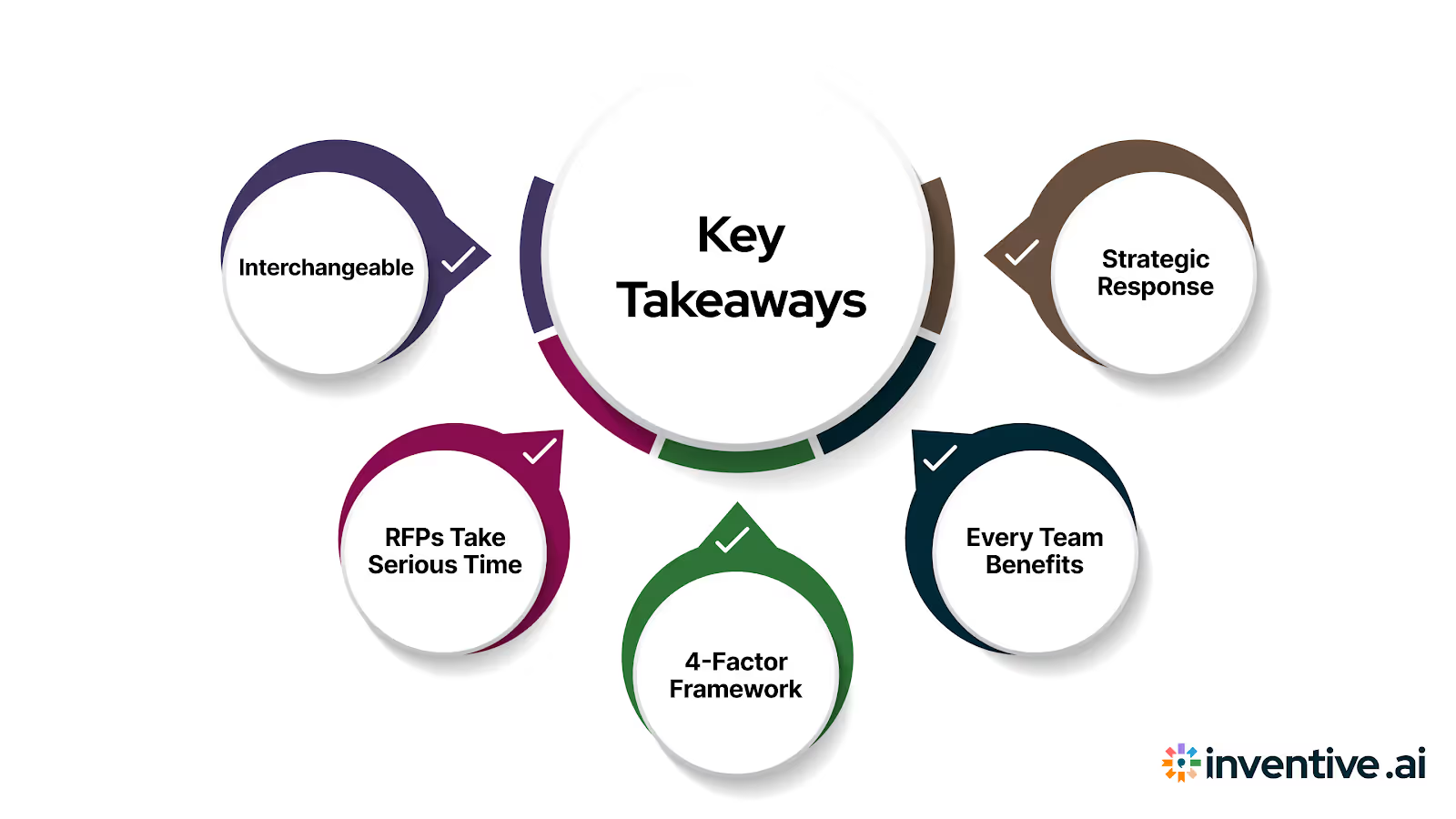
- RFQs and RFPs aren’t interchangeable. RFQs are fast, price-first requests with low customization, while RFPs require multi-team coordination, custom solutions, and strategic positioning.
- RFPs take serious time. Vendors spend up to 23 hours per RFP, often pulling in 5 or more stakeholders across sales, solutions, and legal. That effort needs to be matched by deal value and win probability.
- Use a 4-factor framework to qualify. Evaluate each request based on deal size, customization burden, internal SME time, and your likelihood to win. Score high-opportunity RFPs in, and walk from mismatched RFQs or vague asks.
- Every team benefits. Sales moves faster. Solutions stays focused. Proposal managers deliver higher-quality responses with less friction.
- Strategic response beats speed alone. With Inventive AI, vendors do not just respond faster. They respond to the right deals with smarter content and higher win rates.
What RFQs and RFPs Mean For a Vendor
On the surface, both RFQs and RFPs are formal requests from buyers. However, the expectations behind each are fundamentally different, and for vendor teams, that can make all the difference.
A Request for Quote (RFQ) is typically used when the buyer has a clear understanding of their requirements. The focus attribute here is cost, and the scope is fixed.
They usually cover standardized products or repeatable services, and the buyer expects a simple, apples-to-apples pricing comparison. From your end, that means limited input from SMEs, minimal content reuse, and little room for storytelling or differentiation.
A Request for Proposal (RFP) is more open-ended. In these cases, the buyer may be clear on the problem but also seek strategic input on the solution. These often include complex questionnaires, evaluation criteria beyond price, and custom requirements that demand coordination across presales, solutions, legal, and delivery teams.
In essence, these are not just about pricing; they are about value, risk, fit, and innovation.
In either case, your deliverables are clear:
- RFQs may need a pricing sheet and a short description.
- RFPs often demand 20 to 50 pages of tailored responses, backed by proof points, case studies, and internal alignment.
You may also encounter related formats, such as RFIs (Requests for Information) or EOIs (Expressions of Interest). These are different documents that serve as precursors to an RFP, focused on vendor capabilities rather than commercial commitments.
Once you recognize how RFPs and RFQs impact your internal workload, timelines, and resources, you will be able to position yourself as a strategic vendor.
RFQ vs RFP: A Vendor-Side Comparison That Helps You Decide
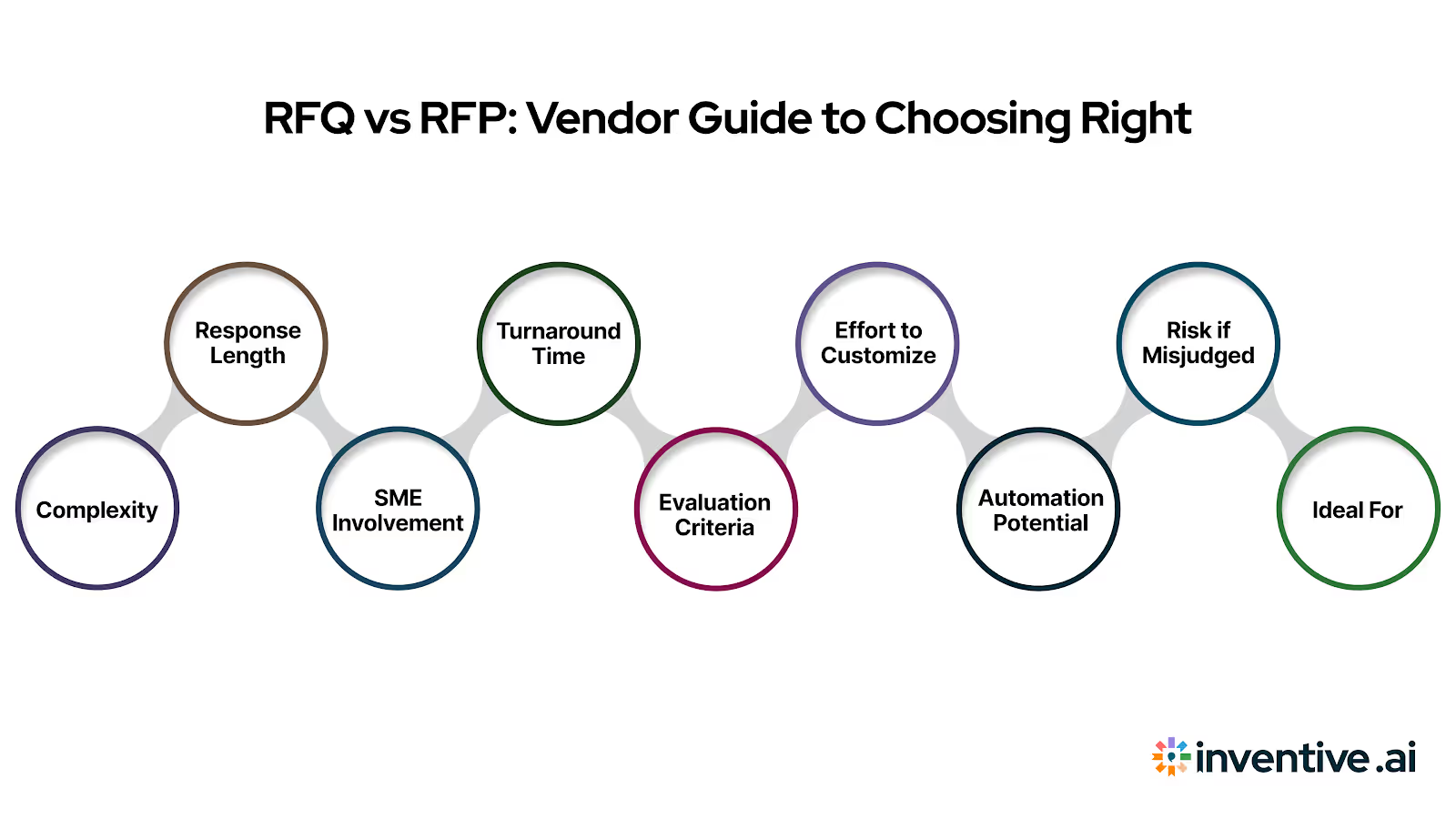
Once you understand the fundamentals, the next step is to assess how RFQs and RFPs affect your internal process, going beyond definitions. It’s about time, effort, risk, and return.
Use the table below to align your go/no-go decisions with the actual demands of each request on your team.
Practical Takeaway: Responding to an RFQ might require a few hours, basic product details, and a final quote. An RFP, on the other hand, could involve multiple team members, version-controlled drafts, and extensive coordination across departments.
The table makes one thing clear: RFQs and RFPs ask very different things of your team. Some are quick wins. Others require significant time, effort, and coordination.
For that, you need a framework that serves as a filter to qualify and discard opportunities that do not work.
Vendor Decision Framework: When to Qualify, When to Walk
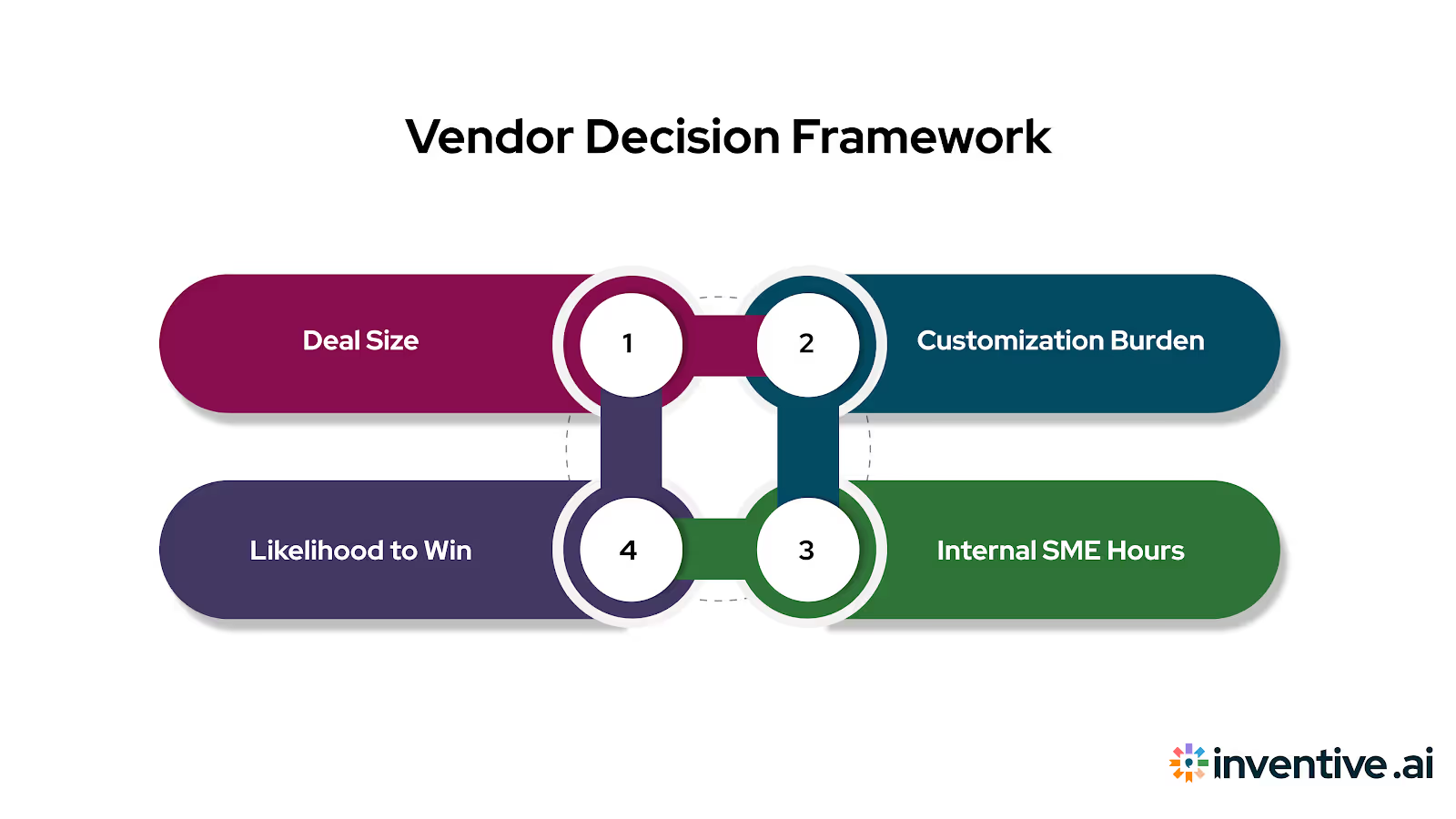
Every opportunity can look attractive at first glance. But when your team is balancing multiple RFQs and RFPs, knowing where to invest your time is essential. This framework helps you evaluate each opportunity objectively—qualifying not just the document, but the deal behind it.
Use this framework to decide when to commit and when to walk away.
Key Factors to Score
Deal Size
What it is: The potential revenue or contract value tied to the opportunity.
Why it matters: Larger deals can justify the cost of mobilizing your team, pulling in SMEs, and investing in a full-scale RFP response. Smaller deals may not provide enough ROI to warrant heavy effort, especially if they require the same level of work as bigger ones.
Outcomes:
When you prioritize deal size effectively:
- High-value deals get the attention and resources they deserve.
- Low-value opportunities that drain time are deprioritized or declined.
- Teams shift from reactive bidding to strategic pursuit, focusing on deals with clear financial upside.
Customization Burden
What it is: The degree of unique or tailored input required in your response.
Why it matters: Highly customised RFPs consume disproportionate resources. If every section requires new content, original pricing models, or one-off solutions, your team’s scalability suffers. Standardized or reusable content enables faster turnaround and reduces the risk of errors.
Outcomes:
Evaluating customisation burden early helps you:
- Predict the real level of effort required to respond.
- Avoid tying up SMEs and writers in overly complex responses for low-margin deals.
- Focus on RFPs where existing assets and prior responses can be leveraged for speed and consistency.
Internal SME Hours
What it is: The total time required from subject matter experts, legal teams, presales, and other stakeholders.
Why it matters: Every hour pulled from SMEs is an hour diverted from revenue-generating or client-facing work. The more stakeholders you involve, the higher the coordination cost and the longer the turnaround time.
Outcomes:
When SME demand is measured upfront:
- Teams avoid last-minute bottlenecks and burnout.
- Proposal managers can allocate resources intelligently, engaging SMEs only where their expertise adds value.
- Review cycles become faster and more efficient, as SME input is structured rather than reactive.
Likelihood to Win
What it is: Your probability of securing the deal based on relationships, competitive positioning, and fit.
Why it matters: Even well-executed proposals are wasted if win probability is low. Without an inside track, established credibility, or clear differentiators, your team risks sinking dozens of hours into a long-shot opportunity.
Outcomes:
Factoring win likelihood ensures that:
- Teams prioritize deals with pre-engagement, existing relationships, or a strong fit.
- High-effort, low-chance bids are flagged early and avoided.
- Resources are aligned with winnable deals, improving overall win rates and ROI on proposal effort.
How to Use It
Assign a score of 1 to 5 for each factor. A combined score above 15 may justify a complete RFP response. Scores below 10 indicate it’s better to push back or decline.
This scoring system establishes a repeatable and objective framework for making go/no-go decisions. Instead of debating instinctively, your team evaluates deals with clear criteria tied to effort, fit, and outcomes.
Examples in Practice
- A 3-page RFQ from an existing customer focused on renewal pricing: Low customization, minimal SME input, high likelihood to win. Clear yes.
- A 47-question RFP with vague scope, no prior engagement, and no decision criteria: High customization, heavy SME lift, low likelihood to win. It's likely a no-go unless the deal size is transformative.
- A well-scoped RFP from a qualified prospect with clear rubrics and engaged stakeholders: Balanced customization, reasonable SME input, strong win probability. Worth pursuing if your team can respond efficiently.
By applying this framework consistently, you transition from a reactive pursuit to a disciplined qualification, focusing your energy where it yields the highest payoff.
See how Inventive AI simplifies response workflows and scales your efforts without extra headcount.
Book a demo to experience faster, more innovative proposal management.
Operational Reality: What Each Response Takes
Every proposal you respond to pulls time, people, and energy from somewhere else. That tradeoff is easy to ignore until your sales cycle slows down or your team starts missing deadlines.
Here’s what responding to an RFQ or RFP typically involves behind the scenes.
RFQs: Fast, Focused, but Still a Commitment
Most RFQs are straightforward. They usually involve 2 to 3 team members; often a sales and a pricing lead, and can be completed in 5 to 8 hours. The request is explicit, the deliverables are fixed, and the risk of misalignment is low. However, even here, delays can occur if content isn’t centralized or pricing approvals are slow.
RFPs: Complex, Collaborative, and Costly When Mismanaged
RFPs can easily consume 20 to 40 hours or more, spread across multiple contributors. Sales, solutions engineering, legal, compliance, and executive stakeholders may all need to weigh in on the decision.
The workload is not just about writing. It’s about:
- Managing SME calendars across time zones
- Chasing last-minute approvals
- Reformatting answers pulled from scattered sources
- Ensuring messaging consistency from one section to the next
- Scrambling to replace outdated boilerplate
Multiply this by three to five open RFPs at once, and your team is not just stretched—it’s overloaded. And yet, not all of that effort is strategic. Too often, the manual work behind a proposal is spent organizing, chasing, and formatting rather than positioning your solution to win.
That’s where the next evolution begins: by removing low-value tasks that drain your team’s time and letting them focus on what truly drives results.
Is the Supplier Vetting Process Fair? A Look Behind the Curtain of Evaluation
Even strong proposals can fall short if you don’t understand how evaluation really works. From a vendor’s perspective, the process can feel inconsistent or opaque. In reality, it is driven by how buyers manage risk, compliance, and internal politics.
Procurement teams often follow a defined scoring rubric, but additional factors shape the outcome. Understanding these dynamics helps you position your response more effectively.
1. Pre-Engagement Shapes Perception
Buyers often favor vendors they have interacted with before the RFP is issued. Early conversations, informal demos, or capability briefings build familiarity and reduce perceived risk.
Takeaway: Visibility before the RFP gives you a measurable advantage and establishes trust before evaluation begins.
2. Scoring Criteria Flex with Context
Published rubrics do not always tell the whole story. Cost may be listed at 30% but it can weigh more heavily in tight budget cycles. In strategic projects, innovation or risk mitigation may take precedence over price.
Takeaway: Align your proposal with both the stated criteria and the underlying business pressures influencing the decision.
3. Compliance is the First Gate
Evaluations often start with a pass-or-fail compliance check. A missing attachment, skipped question, or outdated boilerplate can disqualify a response before scoring begins.
Takeaway: Treat compliance as a threshold requirement. Follow instructions exactly and remove any points of friction.
4. Multiple Stakeholders Hold Influence
Teams outside of procurement, such as legal, IT, or operations, often influence outcomes. One unresolved objection related to security, data privacy, or SLAs can derail an otherwise strong proposal.
Takeaway: Address common cross-functional concerns directly to reduce internal objections before they arise.
5. Prepared Vendors Stand Out
Procurement teams prioritize vendors that present clear, structured, and accurate responses. Clarity signals reliability and reduces risk in the buyer’s eyes.
Takeaway: Well-organized proposals make evaluation easier and increase confidence in your ability to deliver.
When you understand how supplier vetting truly works, you can position your proposal to meet both stated and unstated buyer expectations.
How Inventive AI Changes the Game for RFP Responders
The challenge with most RFP responses isn’t the writing itself. It’s the manual overhead that surrounds it: hunting for content, juggling SME input, and formatting under pressure.
This slows teams down and drains resources that could be better spent on strategy. McKinsey found that deploying AI to analyze historical RFPs and competitor data cut the time needed to assess competitors’ capabilities by up to 60-80%.
Inventive AI streamlines this entire process, enabling your team to transition from a scattered to a structured approach, from a reactive to a proactive one.
Here’s what changes when your response process is built for speed and scale:
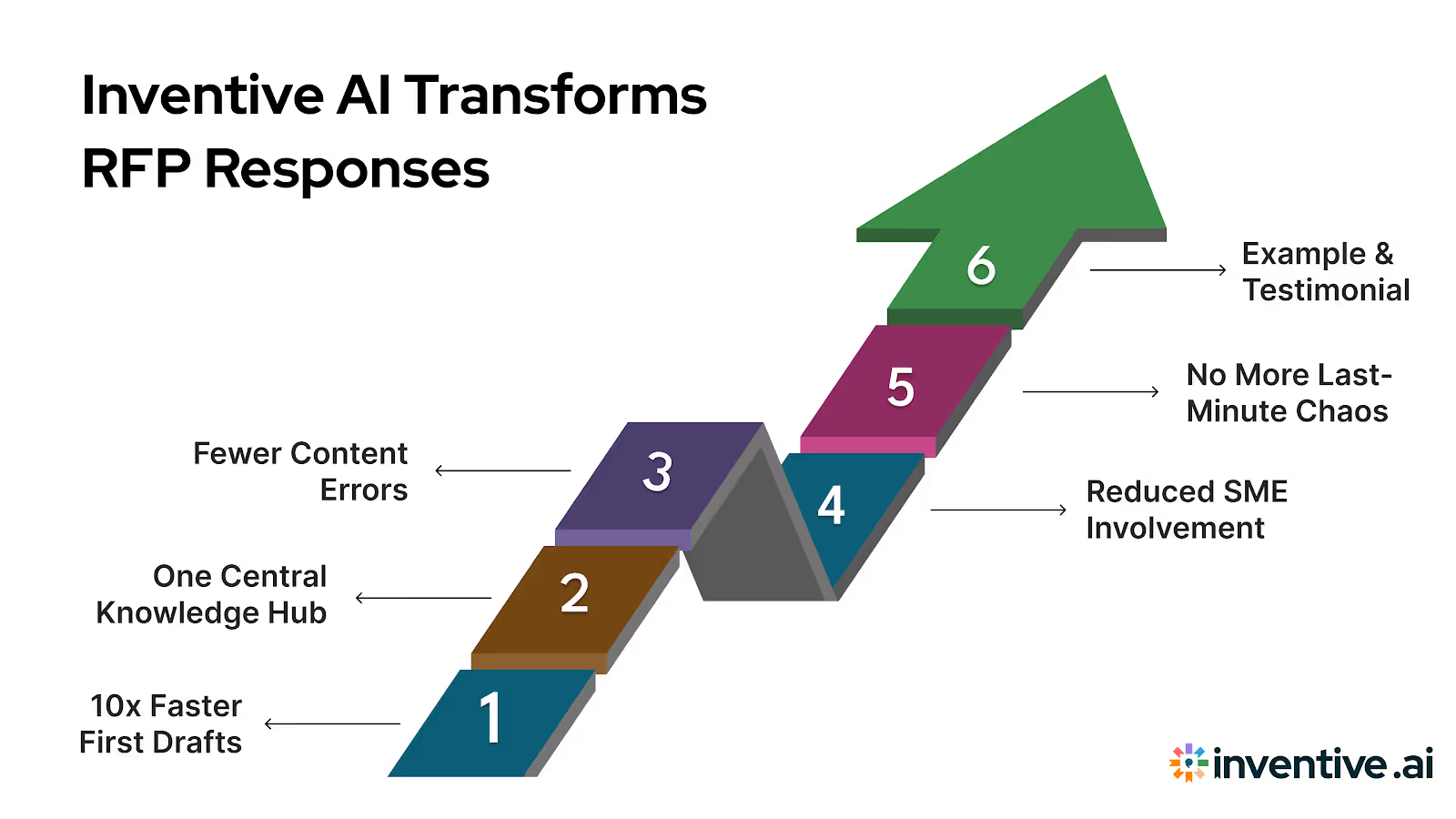
10x Faster First Drafts
Instead of starting from scratch, Inventive AI’s RFP Agent auto-generates a complete first draft using your approved content library. This eliminates blank-page delays and accelerates the kickoff, allowing your team to spend time refining responses rather than building them from scratch.
One Central Knowledge Hub
Content sprawled across multiple drives wastes hours. Inventive AI centralises all your proposal content in one searchable hub, integrating seamlessly with SharePoint, Google Drive, and more. This reduces hunting time, streamlines collaboration, and ensures your team works from a single source of truth.
Fewer Content Errors
Outdated content can sink credibility fast. Inventive AI’s AI-powered content manager auto-flags stale or conflicting material before it’s reused.
This safeguards accuracy, minimises review cycles, and ensures every response reflects your latest positioning.
Reduced SME Involvement
Subject Matter Experts are pulled into too many repetitive tasks. With Inventive AI, core sections are pre-filled automatically, requiring SMEs only when their expertise adds value.
This protects SME bandwidth and frees them up for strategic pursuits, reducing bottlenecks in every response cycle.
No More Last-Minute Chaos
Inventive AI’s Win Themes and guided workflows provide a straightforward narrative and structure from day one.
This aligns responses with the deal strategy early, reduces last-minute rewrites, and eliminates the deadline scramble.
With AI-powered RFP response software, Inventive AI removes the manual burden and frees your team to focus on what matters most: winning.
Real-World Example and Testimonial
One software vendor reduced their average RFP turnaround from five days to just under two by centralizing their knowledge base and using Inventive AI’s RFP Agent to generate first drafts. This allowed their presales and solutions teams to focus on tailoring answers, not tracking them down.
“Saved our Presales team a ton of time. Response quality is high, and the chatbot is useful for ad hoc responses.”
– Verified G2 reviewer, Solutions Engineering
Trust builds with proof. And the proof is in faster responses, fewer delays, and more deals closed.
Conclusion
The difference between an RFQ and an RFP is not just a formatting detail. It affects how your team scopes the work, allocates time, and decides whether to respond at all.
Top-performing vendors do not treat every request the same. They qualify early, respond strategically, and focus their efforts where they have the highest return.
Maintaining that level of discipline across multiple opportunities is difficult without the proper support. Inventive AI brings structure, speed, and accuracy to every aspect of the RFP response process, from the initial draft to final delivery.
Frequently Asked Questions
1. What is the difference between an RFQ and an RFP?
An RFQ (Request for Quote) is a price-driven document used when the buyer knows exactly what they want to purchase. It typically requests simple pricing for predefined products or services. An RFP (Request for Proposal) is a more complex and open-ended process, asking vendors to propose detailed solutions, often with multi-section responses that involve cross-functional teams.
2. What’s an RFI, and when is it used?
An RFI (Request for Information) is used early in the procurement process to gather insights about potential vendors’ capabilities. It helps buyers narrow down the field before issuing a formal RFP or RFQ.
3. Who needs to be involved in an RFP response?
RFP responses typically require input from sales, solutions engineers, legal, compliance, and executive teams. Unlike RFQs, which might only involve a pricing lead, RFPs demand collaboration across departments and significantly more time to complete.
4. How complex are typical RFQs?
RFQs are generally short and to the point. They cover standardized offerings and can often be completed with minimal effort. However, even small RFQs can stall if pricing isn’t aligned or internal approvals are delayed.
5. When should vendors walk away from an RFP?
If an RFP scores low on factors like deal size, likelihood to win, and strategic fit, it’s worth reconsidering. A simple qualification framework can help you decide which opportunities are worth the investment and which ones risk wasting valuable team hours.


